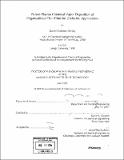Pulsed-plasma chemical vapor deposition of organosilicon thin films for dielectric applications
Author(s)
Burkey, Daniel D
DownloadFull printable version (7.038Mb)
Other Contributors
Massachusetts Institute of Technology. Dept. of Chemical Engineering.
Advisor
Karen K. Gleason.
Terms of use
Metadata
Show full item recordAbstract
As semiconductor feature sizes decrease and feature density increases, the industry is facing the increasing challenge of finding materials that can meet the stringent demands of the next generation of devices. One of the most intense, as well as diverse, fields of research has been in the area of low-k and ultralow-k dielectric materials. Dielectric materials play a key role in semiconductor manufacturing, as they are the insulating material between the metal lines that conduct electronic signals back and forth over a chip. Reducing the dielectric constant of the insulating material allows smaller device geometries, as well as providing other benefits. The best insulator available is vacuum, so by incorporating it into a denser structure in the form of void space or pores, it is possible to lower the dielectric constant of the structure and create a better insulator. The typical methodology for creating a porous thin film relies on the matrix-porogen model, in which a labile material (the porogen) is co-deposited with the dense material (the matrix), and is then removed in a subsequent processing step, leaving behind the void structure. This method has been successfully demonstrated using conventional wet chemistry techniques, but a vacuum-based adaptation of the process that is more compatible with the rest of the semiconductor fabrication process has remained elusive. This thesis is concerned with the fabrication of porous thin film dielectrics using an all-chemical vapor deposition (CVD) approach and adhering to the matrix/porogen paradigm. This first required the identification of suitable porogen candidates that could be fabricated using the CVD technique and still retain the desired labile qualities. Initial integration of this porogen with the chosen organosilicon matrix material resulted in film collapse rather than the formation of voids. In order to prevent this, an extensive study of the mechanical properties of the matrix material was performed, with identification of key structure-property-processing relationships that allowed for the enhancement of mechanical properties while maintaining favorable conditions for the deposition of the porogen species. Integration of the optimized system and subsequent removal of the porogen sacrificial material resulted in thin films with properties suggesting porosity and dielectric constants as low as 2.3.
Description
Thesis (Ph. D.)--Massachusetts Institute of Technology, Dept. of Chemical Engineering, 2003. Includes bibliographical references.
Date issued
2003Department
Massachusetts Institute of Technology. Department of Chemical EngineeringPublisher
Massachusetts Institute of Technology
Keywords
Chemical Engineering.